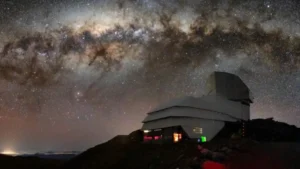An extraordinary meteorite exploded in the sky over Germany this January, creating an impressive light show and triggering a search for its remains.
Scientists eventually confirmed that the celestial object, named 2024 BX1, was an aubrite. The designation stems from the first recorded instance of such an object, near Aubres, France in 1836.
But this space rock’s life span reaches back much farther than that. Though extremely rare, aubrites come from an ancient source that could help explain the origins of our planet.
Needle in a haystack
Krisztian Sarneczky first detected 2024 BX1 at Hungary’s Konkoly Observatory. This itself was quite a feat because the object was so tiny, only about one meter wide. Most meteorites that create such dazzling light shows can be 20 times as big.
After Sarneczky identified 2024 BX1, NASA’s Near-Earth Asteroid Scout and the European Space Agency’s Meerkat Asteroid Guard picked up the tracking. They confirmed that it would strike Earth.
Various teams then tried to read its trajectory to estimate its impact point. Czech experts first accounted for factors like wind speed, noting that the light 2024 BX1 emitted as it broke apart could indicate its type.
It blazed through the sky over Munich, Germany, creating a spectacular display but no damage on the ground. Peter Jenniskens, a meteor astronomer with the Search for Extraterrestrial Intelligence (SETI), led the ensuing search effort for its remains.
“Our search team initially could not easily spot [2024 BX1’s fragments] on the ground,” SETI said in a press release. “We only spotted the meteorites after a Polish team of meteorite hunters had identified the first find and could show us what to look for.”
From outer space’s primordial soup
Looking at the meteorite’s fragments, it’s easy to understand why the team had a hard time spotting them. Aubrites are distinct from typical meteorites in the color of glass they create on their surfaces as they tear through the atmosphere. Instead of the usual black coating, aubrites generate translucent glass on their surfaces.
The result? Meteorites that look basically like globs of gray granite.
View this post on Instagram
Of course, that’s the last thing they actually are. According to Space.com, aubrites account for only 1% of all recovered meteorites worldwide. They also originate from a belt of cosmic debris between Mars and Jupiter that likely formed at the same time as the solar system’s planets.
2024 BX1’s birthday: likely around 4.5 billion years ago, from material around the infant sun that didn’t get eaten up during planetary formation.
“It’s very cool,” Jenniskens told Space.com. “We have fresh material to look at that may have been the building blocks from which Earth was formed. And so that’s the appeal of this particular meteorite.”






